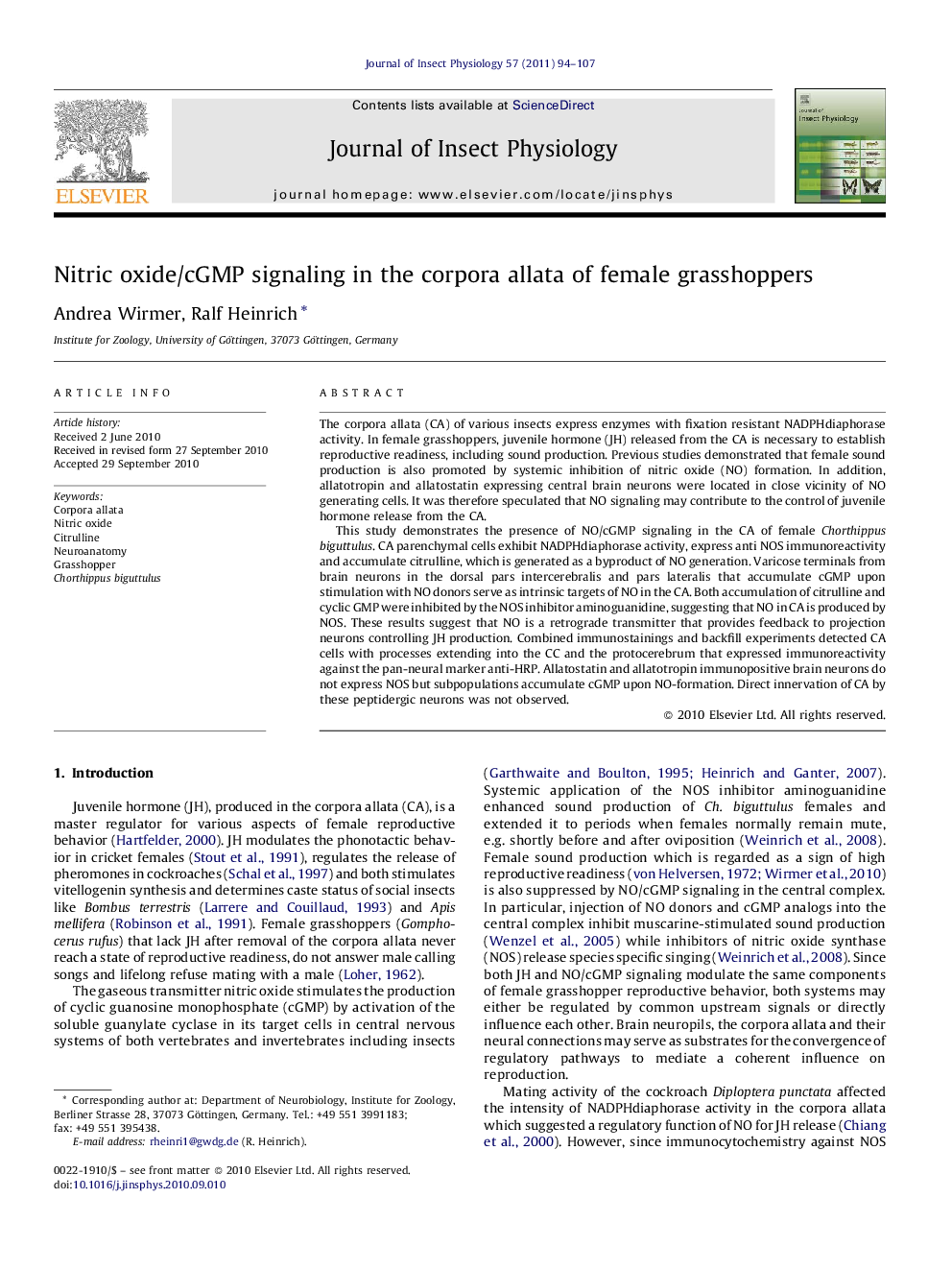| کد مقاله | کد نشریه | سال انتشار | مقاله انگلیسی | نسخه تمام متن |
|---|---|---|---|---|
| 2840968 | 1165368 | 2011 | 14 صفحه PDF | دانلود رایگان |

The corpora allata (CA) of various insects express enzymes with fixation resistant NADPHdiaphorase activity. In female grasshoppers, juvenile hormone (JH) released from the CA is necessary to establish reproductive readiness, including sound production. Previous studies demonstrated that female sound production is also promoted by systemic inhibition of nitric oxide (NO) formation. In addition, allatotropin and allatostatin expressing central brain neurons were located in close vicinity of NO generating cells. It was therefore speculated that NO signaling may contribute to the control of juvenile hormone release from the CA.This study demonstrates the presence of NO/cGMP signaling in the CA of female Chorthippus biguttulus. CA parenchymal cells exhibit NADPHdiaphorase activity, express anti NOS immunoreactivity and accumulate citrulline, which is generated as a byproduct of NO generation. Varicose terminals from brain neurons in the dorsal pars intercerebralis and pars lateralis that accumulate cGMP upon stimulation with NO donors serve as intrinsic targets of NO in the CA. Both accumulation of citrulline and cyclic GMP were inhibited by the NOS inhibitor aminoguanidine, suggesting that NO in CA is produced by NOS. These results suggest that NO is a retrograde transmitter that provides feedback to projection neurons controlling JH production. Combined immunostainings and backfill experiments detected CA cells with processes extending into the CC and the protocerebrum that expressed immunoreactivity against the pan-neural marker anti-HRP. Allatostatin and allatotropin immunopositive brain neurons do not express NOS but subpopulations accumulate cGMP upon NO-formation. Direct innervation of CA by these peptidergic neurons was not observed.
NO/cGMP signaling in the corpora allata of female grasshoppers. Projection neurons from the pars lateralis and pars intercerebralis in the protocerebrum (green) enter the corpora allata via the nervus corporis allatum I (NCA I) and release a yet unidentified transmitter (presumably a peptide or amine) from varicose endings (1) that regulates parenchymal cells’ (red) activity including juvenile hormone synthesis. This transmitter activates the formation of the gaseous transmitter nitric oxide (NO) by nitric oxide synthase (NOS) in parenchymal cells (2). NO serves as a retrograde signal that increases the production of cGMP in the presynaptic terminals of the amine or peptide releasing brain neurons (3). NO stimulated cGMP accumulation in projections of brain neurons is shown on the right. CA also contain NOS expressing cells (blue) that express the insect neuronal surface marker Nervana and project processes into the corpora cardiaca (CC) and the brain.Figure optionsDownload as PowerPoint slideResearch highlights▶ Proof is provided that nitric oxide (NO) is generated by intrinsic corpora allata cells of female grasshoppers by demonstrating NADPHdiaphorase activity, presence of nitric oxide synthase and presence of citrulline, which accumulates as a byproduct during NO formation. ▶ Cellular targets of NO in the corpora allata accumulate cyclic GMP upon stimulation with NO donor. NO responsive structures are identified as varicose terminals from projection neurons with cell bodies in the pars intercerebralis and pars lateralis of the protocerebrum. ▶ Suppression of citrulline and cGMP accumulation in the corpora allata by systemic application of the nitric oxide synthesis inhibitor aminoguanidine indicated that NO functions as a transcellular signal generated by NO synthase and not as a byproduct of a metabolic pathway. ▶ Some NO synthase expressing corpora allata cells project into the brain. This suggests two things that so far have not been considered, a bidirectional flow of information between the brain and the corpora allata and diverse types of corpora allata cells that may serve functions additional to juvenile hormone production. The hypothesis that some of these corpora allata cells could be of neuronal type, was substantiated by immunolabeling the neuron-specific surface marker Nervana with an anti-HRP antibody. ▶ Though allatotropin and allatostatin expressing brain neurons don’t innervate the corpora allata, they are targets of nitric oxide signaling and may indirectly regulate corpora allata functions.
Journal: Journal of Insect Physiology - Volume 57, Issue 1, January 2011, Pages 94–107